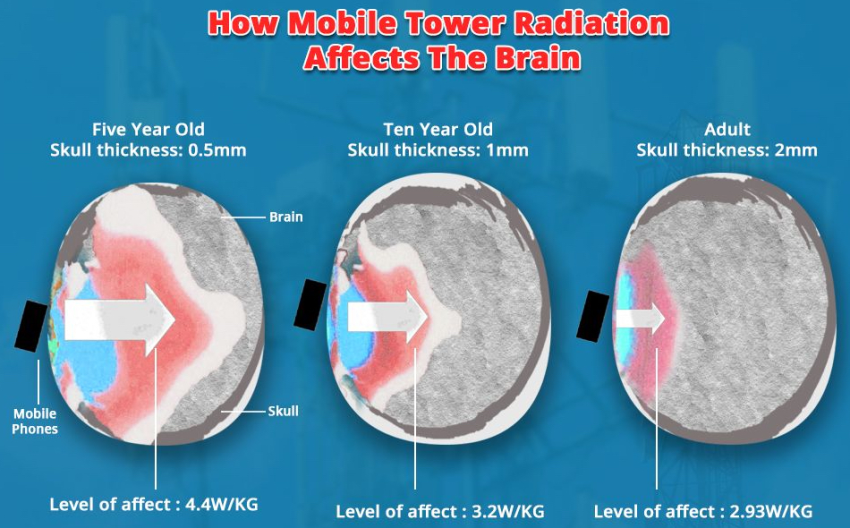The radiation RF-EMF causes damages to DNA and tissue and disrupt the blood-brain barrier. These effects are real and ARPANSA is active in collaborating within the EHS community, medical experts and researchers. ARPANSA will continue to study research related to the health impacts of EMF radiation.
DNA damage is caused by RF-EMF
Exposure to man-made electromagnetic fields (EMFs) are associated with DNA damage as well as health consequences. EMFs can disrupt the intracellular ionic concentrations that are crucial to maintain a cell's electrochemical balance. It can also cause disruption to cell homeostasis and result damages to the DNA. Furthermore, exposure to EMFs can also trigger an increase in the production of free radicals as well as reactive oxygen species (ROS).
Exposure to RF-EMF radiation has been linked to changes in male germ cell development. This is due to the transformation of germ cells into spermatozoa, aswell maturation of the functional aspect as spermatozoa travel through the epididymis. To investigate the sensitivity of RF-EMF exposure to the development of male germ cells, a specifically-designed waveguide device was developed to expose unrestrained mice to RF-EME in the range of 2.2 W/kg.
In a study that was conducted recently, researchers discovered that exposure to RF-EME triggered the oxidation of DNA in the spermatozoa. Sperm DNA fragmentation was increased by 18% after one week of treatment and by 23 percent after 5 weeks. Furthermore, DNA damage in mitochondria was observed by measuring the level of a biomarker, 8-hydroxy-2-deoxyguanosine (8-OH-dG).
Despite this the fact that RF-EMF radiation isn't yet considered to be a carcinogen. But, numerous studies have found that RF-EMF exposure can impair the integrity of DNA in variety of cell varieties. In one of these studies, scientists subjected Vero cell lines to EMF that was 100Hz, for about 45 minutes. They evaluated DNA damage within 48 hours of exposure to determine if exposure affected DNA integrity.
The effect of RF-EMF on tissue heating
Although the effects of RF-EMF are generally thought as thermal in nature, a few studies have shown that non-thermal effects are also evident. These may be the reason for certain of the unsolved findings in epidemiological studies on EMF hypersensitivity. emf radiation is why it is crucial to take into account non-thermal effects when conducting systematic reviews.
Non-thermal effects from RF-EMF could be mediated by the cell membrane. This is a field where research has been extensively studied. In particular the electrochemical properties of cell membranes is being studied. is emf radiation harmful is that energy from RF-EMF higher than 1 MHz is transmitted to tissues via dielectric and ionic dissipation. The theoretical studies have indicated that the energy that is transferred to the tissue could be up to 200 kV/m.
The electric properties of tissue are regulated by the composition and distribution of water molecules, ions, and other molecules inside the body. This determines how absorbent EMR RF is by various tissues. The tissues with the highest conductivity tend to absorb more EMR field and produce more of an impact. This is the reason why the amount of tissue heating does not increase steadily between the outside and inside and is only noticeable in hot areas. Bone and fatty tissue are less susceptible to heating by RF than other tissues, because they are low in water content.

The intensity of the field's electromagnetic energy depends on the strength and frequency of field. Muscle tissue is more able to absorb field energy than other tissues and converts it to heat more effectively. Usually the depth of penetration that RFEMF has is measured as millimeters (mm). But, the greater the frequency, the shallower the penetration.
RF-EMF causes blood-brain barrier disruption
Researchers have discovered that RF-EMF can alter the blood-brain-barrier, altering sleep patterns and neurotransmitter levels. Additionally, the effects that EMF in brain activities are associated with neurodegenerative disorders. For instance, EMF from mobile phones could affect the electroencephalogram's activity and sleep patterns, and the activity of nitric oxide and xanthin oxidase.
Researchers from the Vienna University have studied the effects of exposure to RF EMF to brain cells. They also studied what effects ELF EMFs on the brain system. Though the cellular mechanisms aren't completely comprehended but there is a clear relationship between exposure to ELF EMF and depletion of myelin. This relationship might account for the electro-hypersensitivity symptoms of electro-hypersensitivity. Fortunately, there are some tested methods to regenerate myelin inside the brain.
Researchers have discovered that exposure to the frequency of 900 millimeters EMF caused a rise in the permeability of BBB and raised symptoms of neuronal damage in rats. They also observed increased extravasation of neuronal albumin. Furthermore, they discovered the following: after about 30 min of exposure to 900 MHz, 99mTc-MIBI increased its diffusion in the cortex. But emf radiation didn't occur when using Evans blue injections.
Despite these findings, RF EMF is not able to provide a definitive mechanism to disrupt the BBB. The evidence suggests that nonthermal EMF exposure increases erythrocyte membrane permeability, which could affect the BBB and enhance the efflux of calcium-ion. Moreover, the presence of a 99mTc-MIBI radiotracer within the brain is also associated with increasing the permeability and permeability of the BBB.
